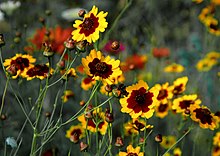Plains coreopsis: Difference between revisions
No edit summary |
m synonyms |
||
| Line 12: | Line 12: | ||
|binomial = ''Coreopsis tinctoria'' |
|binomial = ''Coreopsis tinctoria'' |
||
|binomial_authority = [[Thomas Nuttall|Nutt.]] |
|binomial_authority = [[Thomas Nuttall|Nutt.]] |
||
|synonyms = ''Coreopsis elegans'' |
|||
<br>''Calliopsis elegans''<ref>A biosystematic study of Coreopsis tinctoria and C. cardaminefolia (Compositae). Edwin B. Smith and Hampton M. Parker, Brittonia, Volume 23, Number 2, pages 161-170, {{doi|10.2307/2805432}}</ref> |
|||
|}} |
|}} |
||
Revision as of 19:31, 3 September 2011
| Plains coreopsis | |
|---|---|

| |
| Scientific classification | |
| Kingdom: | |
| (unranked): | |
| (unranked): | |
| (unranked): | |
| Order: | |
| Family: | |
| Genus: | |
| Species: | C. tinctoria
|
| Binomial name | |
| Coreopsis tinctoria | |
| Synonyms | |
|
Coreopsis elegans
| |
Plains coreopsis or calliopsis (Coreopsis tinctoria), is an annual forb. The small, slender seeds germinate in fall (overwintering as a low rosette) or early spring. Growing quickly, plants attain heights of 12 to 40 inches (30–100 cm). Leaves are pinnately-divided, glabrous and tending to thin at the top of the plant where numerous 1- to 1.5-inch (2.5-to 4-cm) flowers sit atop slender stems. Flowers are brilliant yellow with maroon or brown centers of various sizes. Flowering typically occurs in mid-summer.
Distribution
Plains coreopsis is common to much of the United States, especially the Great Plains and southern states where it is often called "calliopsis."
Cultivation
Plains coreopsis grows well in many types of soil, but seems to prefer sandy or well-drained soils. Although somewhat drought-tolerant, naturally growing plants are usually found in areas with regular rainfall. It is often grows in disturbed areas such as roadsides or cultivated fields. Preferring full sun, it will also grow in partial shade.
Because of its easy growing habits and bright, showy flowers such as Roulettte (tiger stripes of gold on a deep mahogany ground), Plains coreopsis is increasingly used for landscape beautification and in flower gardens.
Uses
The flowers of Coreopsis Tinctoria are commonly used for creating dyes.
References
- Everitt, J.H. (2007). Weeds in South Texas and Northern Mexico. Lubbock: Texas Tech University Press.
{{cite book}}: Unknown parameter|coauthors=ignored (|author=suggested) (help) ISBN 0-89672-614-2 - Pink, A. (2004). Gardening for the Million. Project Gutenberg Literary Archive Foundation.
External links
- ^ A biosystematic study of Coreopsis tinctoria and C. cardaminefolia (Compositae). Edwin B. Smith and Hampton M. Parker, Brittonia, Volume 23, Number 2, pages 161-170, doi:10.2307/2805432
